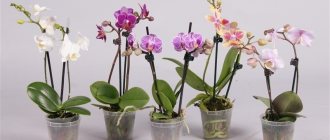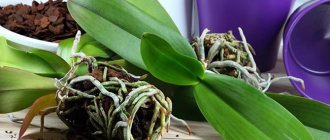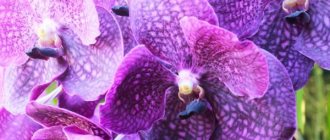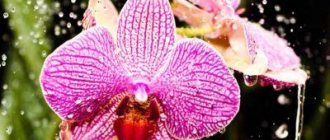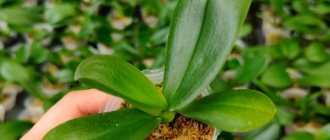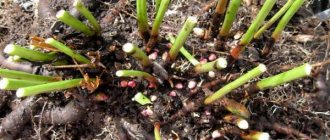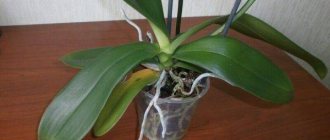The article was prepared by a specialist for informational purposes only. We urge you not to self-medicate. When the first symptoms appear, consult a doctor.
The orchid attracts many gardeners with its beauty. However, this plant is very demanding to care for. If you do not follow certain rules, the orchid may die without ever pleasing its owner with beautiful flowers. Therefore, it is so important to choose the optimal soil for the plant, provide it with sufficient moisture and follow the watering regime.
Adaptation of orchids to apartment conditions
Any move is stressful for the plant. In order for it to endure it with minimal losses, you need to follow the rules of caring for it from the first days of the arrival of a new “tenant” in the apartment.
How long does quarantine last?
Immediately after moving, it is necessary to provide the plant with a 14-day quarantine. The orchid should be placed separately from other flowers. A bedside table is quite suitable for this purpose, provided that there is no place for a flower on the windowsill. In addition, a plant that has been in the store for a long time does not need direct sunlight. The orchid should be given rest.
You should not apply any fertilizers in the first two weeks after moving. It is necessary for the flower to independently adapt to its surrounding conditions.
You should also avoid watering, but you need to carefully monitor the condition of the leaves and stem of the plant. This will allow you to promptly identify possible pests and stop their reproduction.
After 2 weeks, you can put the orchid on the windowsill, but this must be done gradually, at first only in the morning and evening hours, so that it gets used to the sun. From this time you can start watering the flower.
Briefly about orchid transplantation
As a rule, a purchased orchid will not require replanting for two years. However, if the store used Sphagnum moss as soil for the plant, then the flower must be replanted as quickly as possible.
Once the plant is introduced into new soil, there is no need to fertilize it. It is enough just to keep it dry, and it will get used to the new conditions on its own. If there are no insects or stains on the orchid, then there is no need to treat the plant with any preparations. Excess chemicals can harm even a completely healthy flower.
As practice shows, a newly purchased and replanted plant does not need anything other than complete rest. You shouldn't even water it. In this way, it maximizes its own strength and adapts to new conditions.
How to properly care for an orchid?
The orchid is rightfully considered a very capricious plant that requires careful and reverent treatment. It requires the creation of suitable conditions. However, you should not be afraid to start a flower, you just need to know the basic rules of caring for the plant.
Correct lighting
The health of the plant and the frequency of flower appearance depend on how well the lighting is chosen. If the orchid gets enough sunlight, it will bloom regularly. The fact that the plant needs additional lighting will be indicated by pale leaves, which will subsequently stretch out and turn yellow.
In order for the orchid to feel as comfortable as possible, you should follow simple rules:
- The flower should not be exposed to direct sunlight. The light must be diffused.
- During the summer months, it is best to use a frosted window film to slightly darken the plant's habitat. This will avoid burning the leaves.
- In autumn, the sun is not so intense, so the film can be removed. Soft rays will not harm the plant, but will contribute to its comfortable transition to a dormant state. At this time, old shoots ripen, and new shoots are formed, which will become flowers in the future.
- A lack of light harms an orchid no less than its excess. For normal flower growth, daylight hours must last at least 12 hours. Therefore, in winter it is necessary to provide the plant with artificial lighting. To do this, you can use a lamp with fluorescent lamps.
Selecting the optimal temperature regime for an orchid
The temperature regime must be selected depending on the type of orchid:
- The Lady's slipper orchid, as well as flowers of the genus Dendrobium and Lelia, are cold-loving plants. They grow in countries with a subtropical climate, as well as in the highlands. For such varieties of orchids, the optimal summer temperature is 22 degrees, and the winter temperature is 12-15 °C.
- Orchids of the genus Miltonia and Odontoglossum are plants that prefer average temperature values. They grow in mountainous areas of tropical countries. The optimal daytime temperature for such flowers in the summer months is 18-22 degrees, and in winter –12-15 °C.
- Cattleya orchids, Phalaenopsis and some flowers from the genus Dendrobium are heat-loving plants. Their natural habitat is the forest belt of the coastal tropics and tropical plains. The optimal daily temperature range for these varieties is: 15-32 degrees in summer, 15-18 °C in winter. It is important that daily temperature fluctuations do not exceed the range of 3-5 °C.
Thus, almost all orchids are able to tolerate daytime temperatures of 18-27 °C, and night temperatures of 13-24 degrees.
Watering an orchid
An orchid is a plant that does not tolerate stagnant moisture, so watering should be moderate. However, the watering regime varies for different types of flowers. Thus, orchids of the genus Oncidium and Dendrobium require moisture only after the soil is completely dry. In turn, orchids of the Phalaenopsis and Paphiopedilum varieties prefer moist soil.
In any case, all orchids tolerate drought much better than overwatering. During active growth, during the period of release of peduncles and during the flowering process, they require more moisture. Insufficient moisture supply is indicated by the appearance of wrinkles on the leaves and wrinkling of the pseudobulb. An excess of water is characterized by yellowed and soggy leaves, as well as rotting roots.
In winter, at low temperatures and in low light, there is no need to water the plant at all. The orchid's moisture should be very moderate during the period after flowering, as well as during the resting stage.
The water used to water the flower must be soft. It is good if it is possible to water the plant with melted or settled rainwater. If this is not possible, then you should use ordinary boiled water for irrigation.
In the summer months, the need to moisten the soil will be indicated by a dry soil surface. As a rule, 2-3 waterings per week are enough for the orchid to feel comfortable. You should also pay attention to the pseudobulb. If it wrinkles and decreases in size, then the flower needs additional moisture.
It is equally important to water the orchid correctly. To do this, you need to place it directly in the pot in a bowl filled with warm water. The holding time is 10 minutes. You can use the shower, watering the plant from above. In the latter case, it is important to allow excess moisture to drain. To do this, place the pot on a wire rack so that the water drains out through the drainage holes. Only after this can the flower be returned to the decorative pot.
Feeding and fertilizing
Fertilizers should be applied no more than once every 14-21 days. This should be done only when the orchid is in the active growth phase. You can use fertilizers such as Bona Forte, Pocon, Greenworld. You should not add a larger dose of fertilizer to the pot than indicated on the package.
Flowers do not tolerate mineral salts well, and their excessive concentration can lead to the death of the plant. Therefore, it is so important to wash the soil with running water once a week. You can alternate fertilization with flushing: 1 week - watering, 1 week - fertilizing.
You should not use fertilizers that are intended for other plants to feed orchids. There is no need to apply them in winter and during the dormant period.
Most gardeners believe that frequent feeding of an orchid only harms the plant. This negatively affects the state of its natural immunity, as a result of which the flower begins to suffer more often from various diseases.
You can avoid applying fertilizers altogether if you follow the periodicity of soil renewal. In order for the plant to receive all the nutrients from it, the soil must be changed at least once every two years.
Lady's slipper
Also known by the names: cuckoo boots, boots, Maryin's shoe, limestone shoe.
Lady's slipper is a low herbaceous plant up to half a meter high, with a thick rhizome and long thick roots. The flowers of the plant look like shoes, quite large - up to five cm. It blooms predominantly yellow, sometimes red with shades of brown and black. On the lower, swollen lip of the flower you can see red spots or stripes. Lady's slipper blooms only at 15-17 years of age.
Lady's slipper is found on moist, but not swampy soils along the edges of mixed or deciduous forests. Unlike its “sisters” - tropical orchids, lady's slipper withstands frosts.
In April, as soon as the snow in the forest melts, the lady's slipper begins to grow shoots, on which buds form already in May. Flowering lasts about three weeks, after which the pollinated flowers fade, the seeds ripen throughout the summer.
Lady's slipper can often be found in flower beds and flower beds. Thanks to its high decorative qualities, unpretentiousness, and frost resistance, the lady’s slipper has become a favorite among amateur flower growers and designers.
Orchid propagation
Growing orchids is not difficult, but you must follow certain rules. Flower propagation is possible in several ways.
Orchid propagation by stem suckers
Stem suckers or “babies” of an orchid are small new plants. Such shoots are formed in those flowers that have an increased level of nitrogen. If such lateral shoots appear on the orchid, then you should start spraying it more often and wait until the shoots take root. When this happens, you can separate the stem from the main flower, after which it must be treated with powdered charcoal and planted in a separate pot.
Orchid propagation by layering
Layers are found in those orchids that grow horizontally (sympodial plants). They often appear in those flowers whose shoots have an elongated or thickened cylinder shape.
In order for the layering to awaken, you will need to form a small greenhouse over the part of the flower where the buds have formed. To do this, you can use a plastic glass. To increase humidity, you need to spray the moss in the greenhouse, as well as the shoot itself.
After about a month of being in heat and moisture, the buds will awaken and new plants will emerge from them, with their own leaves and roots. All that remains is to carefully separate them from the main trunk, process them and transplant them into a separate pot. To strengthen young shoots, they can be kept in a greenhouse for some time.
Vegetative method of propagation
With the help of vegetation, any species and varieties of plants can reproduce. To do this, you will need to divide the orchid root into several parts. It is important that at least 2 pseudobulbs remain on each part. The rhizome of a young plant should not be divided; it must be mature and strong.
You will need to carefully remove the flower from the pot, shake off the soil from the roots and cut the root into several parts. It is convenient to use garden shears for this. The cuts need to be treated with charcoal and each part of the plant should be planted in different pots. New orchids need to be watered and sprayed. When new leaves or shoots appear, you can stop spraying and intensive watering, as these formations indicate that the plant has taken root.
Orchid
Orchid flowers have more than 35,000 types of varieties and varieties of orchids. In nature, orchids can be found in any part of the earth, but only a small part of this wide variety can be mistaken for indoor flowers.
There are orchids that calmly and easily get used to the conditions of apartments and do not need special care, but you can find orchids, the care and cultivation of which requires a lot of experience and special knowledge in growing orchids.
The orchid flower has a rather interesting structure.
In order to store nutrients and water, orchids have a special thickening at the bottom of the stem, which is called a pseudo bulb; it can be spherical, cylinder-shaped or egg-shaped.
The pseudobulb usually grows on a rhizome. Leaves and peduncles grow from the top of the pseudobulb, and flowers are located on them, which in all types of orchids, despite the huge variety of colors and shapes, have the same structure.
There is a so-called lip - the lower petal of an orchid; two lateral sepals grow on either side of the lip, two lateral petals on top, and the upper sepal adorns the flower.
Each type of orchid needs its own conditions of maintenance, but there are general requirements that must be met for all home orchid flowers.
Special requirements of orchids for air and soil humidity. Orchids require high humidity, but the air temperature must be controlled.
With excess moisture in the substrate, along with low temperatures, orchid roots easily rot. Small forms of orchids grow well in aquariums.
In this case, thanks to the large supply of water in the pseudo bulb, the flower can be practically not watered, but sometimes it is necessary to ventilate.
Orchids are light-loving flowers that require bright, diffused light from 10 to 15 hours a day, and therefore in winter the orchid requires artificial lighting.
In summer, on the contrary, orchid flowers need to be hidden from direct rays of the sun.
The orchid is thermophilic, so the temperature in the warm season is desirable from 20 to 25 degrees, and in winter it should not be less than 17 degrees Celsius. At night it is 2-3 degrees lower.
Orchid soil is a mixture of flower soil and sand.
It is better to use special soil for orchids; it is sold in specialized flower shops.
Pebbles and fragments of foam plastic are used as drainage.
You need to care for orchid seedlings in the above manner, not forgetting to feed them 2-3 times in the summer with complex fertilizers for indoor flowers, diluted by half.
Most often, orchids reproduce by dividing the bush. In this case, it is necessary to try to divide the bushes in such a way that at least three sprouts remain in each part.
You can try to root the cuttings, but with this method you need to take soil that largely contains sand, to which soil for flowers is added, and control soil moisture to prevent rotting of the sprouts.
How to care for an orchid during the flowering phase and after it?
If the plant has formed flowers, then the following care recommendations must be followed:
- It is necessary to water the orchid intensively. The best way to do this is with a shower. The water should be warm. The optimal temperature is 35 °C. It is important that water does not remain at the growing point of the orchid, as this threatens the death of the plant.
- The temperature at night should not be too low. It should be increased by 5 °C from the recommended one.
- It is forbidden to replant the plant during the flowering period.
- During the flowering phase, fertilizing can be applied, but moderation should be observed.
You should not often move the orchid from one place to another, this will increase the flowering period.
Caring for an orchid during the dormant period
After the flower has become dry and blackened, it is necessary to cut it off. The cut must be made at the very base. Feeding during the dormant period should be abandoned or reduced to a minimum. In winter, the orchid is watered once a month, but you can spray the plant more often.
If an orchid does not bloom at the appropriate time, this indicates that it needs to be replanted. You can try moving the pot to another place - this should help. It is also necessary to transfer a flower when its leaves wrinkle and turn yellow, and the peduncle does not appear.
Proper care of such a fastidious plant as an orchid will ensure its regular and long-lasting flowering.
